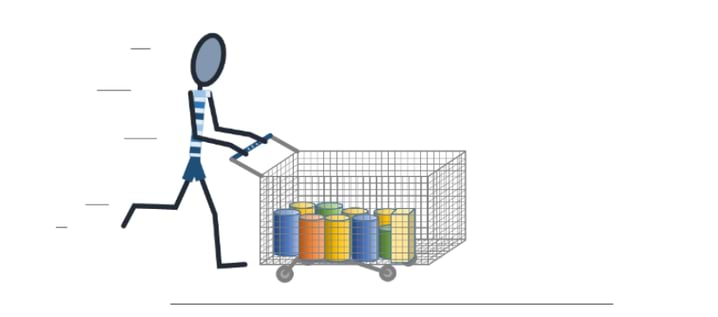Learning focus: | A resultant force on an object can cause it to speed up or slow down, depending on the direction of the force. |
Observable learning outcome: | Explain why friction and other resistive forces make it necessary to exert a constant force to keep an object moving at a steady speed |
Question type: | Simple multiple choice |
Key words: | Force, weight, friction, drag |
When the speed of an object is being increased, students tend to focus on the applied force that appears to be needed to get it going, and keep it going. They often think that a moving object has force that keeps it moving, and which runs out when it comes to rest (Gunstone, R and Watts, 1985; Driver et al., 1994a). Osborne (1985) found that as students get older they increasingly hold the view that a force, pushing in the direction of motion, is needed to keep an object moving. In a study of 200 students he found 46% of 13 year olds believed this, increasing to 53% of 14 year olds and 66% of 15 year olds.
Instead of concentrating on the applied force students need to think about all the forces acting and how they combine to produce the resultant force. They need to identify when it acts, when it changes and when it ceases. This involves understanding friction and the direction it acts in in order to recognise how it contributes to the resultant force (Driver et al., 1994b).
For most students the idea that a bigger force produce a bigger effect is intuitive, but it is important to emphasise that force does not produce speed, but a change in speed (Driver et al., 1994b). In other words: any moving object will continue to accelerate whilst a resultant force is acting on it.
This question investigates students’ understanding of how resultant forces of zero and non-zero size affect the speed of a moving object.
Students should complete the questions individually. This could be a pencil and paper exercise, or you could use an electronic ‘voting system’ or mini white boards and the PowerPoint presentation. The follow on question will give you insights into how they are thinking and highlight specific misconceptions that some may hold.
If there is a range of answers, you may choose to respond through structured class discussion. Ask one student to explain why they gave the answer they did; ask another student to explain why they agree with them; ask another to explain why they disagree, and so on. This sort of discussion gives students the opportunity to explore their thinking and for you to really understand their learning needs.
Differentiation
You may choose to read the questions to the class, so that everyone can focus on the science. In some situations it may be more appropriate for a teaching assistant to read for one or two students.
In question 1, students may choose answers A and B based on their experience that heavier trolleys are harder to start moving or to stop. Answer B suggests students think a bigger forwards force is needed than the resisting force, as do answers D and E.
Question 2 is more challenging. Answer A may suggest students hold the view that a force, pushing in the direction of motion, is needed to keep an object moving, and twice the force implies twice the speed. Answer B is similar, however students selecting this answer are probably taking into account the increased friction. Answer C shows understanding that there is a forwards resultant force to increase speed. The correct answer, D, requires students to understand that the forwards resultant force increase speeds, and therefore increases friction – until the force of friction increases to the same size as the forwards force, at which point there is no further change of speed.
If students have misunderstandings about why friction and other resistive forces make it necessary to exert a constant force to keep an object moving at a steady speed, a good question to ask for each situation is ‘what force is left over to speed-up the trolley or to slow it down?’ Discussing, in pairs or small groups, examples of situations in which the amount of friction (or drag) changes can encourage social construction of new ideas through dialogue. Giving students the opportunity to write an explanation for each example in their own words can consolidate learning and check individual understanding. Suitable examples might be: going down a playground slide at different speeds; or cycling through still air at different speeds.
The following BEST ‘response activity’ could be also be used in follow-up to this diagnostic question:
- Response activity: Trolley racing
Driver, R., et al. (1994a). Making Sense of Secondary Science: Research into Children's Ideas, London, UK: Routledge.
Driver, R., et al. (1994b). Making Sense of Secondary Science: Support Materials for Teachers, London: Routledge.
Gunstone, R and Watts, M. (1985). Force and Motion. In Driver, R, Guesne, E. & Tiberghien, A. (eds.) Children's Ideas in Science. Milton Keynes, England: Open University Press.
Osborne, R. (1985). Building on children's intuitive ideas. In Osborne, R & Freyberg, P. (eds.) Learning in Science Aukland, New Zealand: Heinemann.
